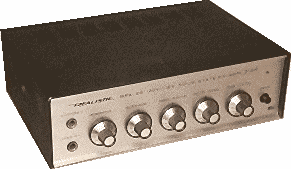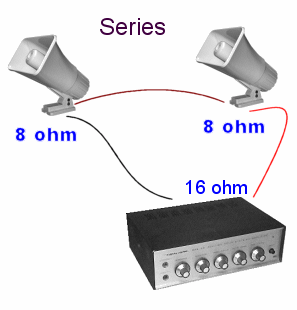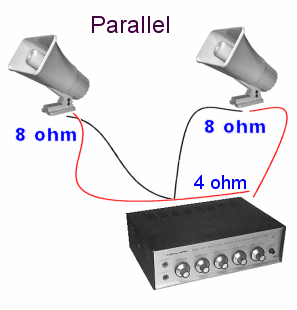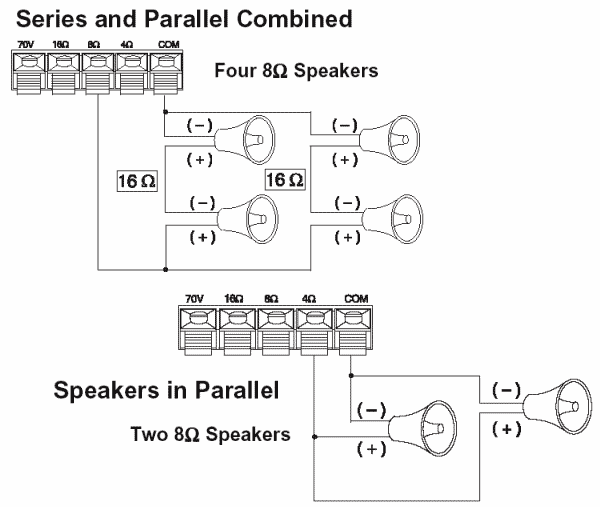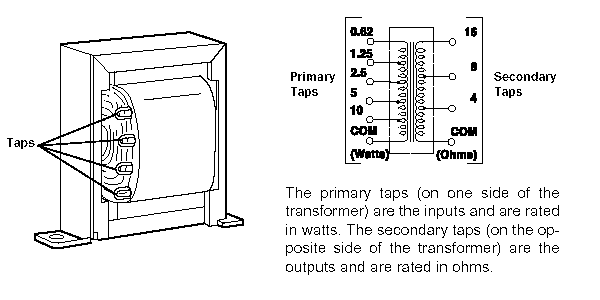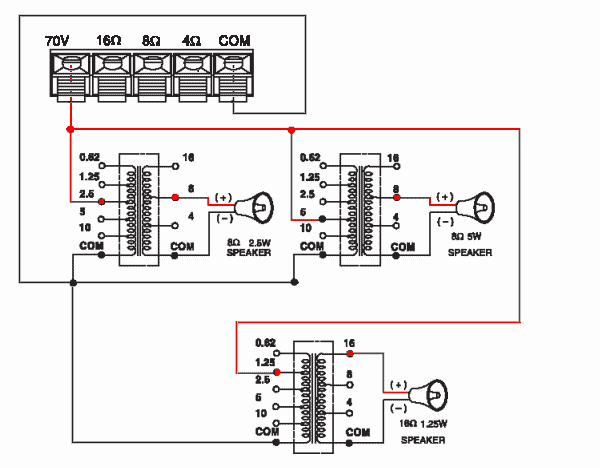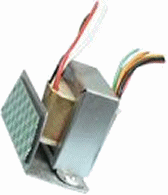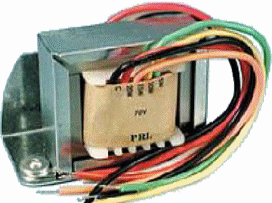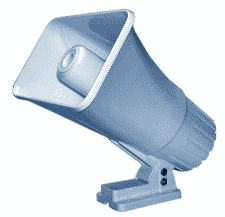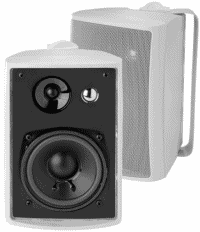Multiple Speaker Public Address and Intercom System
The amplifier is a Realistic MPA-20 Solid State Amp. This is used instead of an old stereo receiver due to longevity of operation. This unit must remain powered on 24/7 to facilitate as the amplification for the alarm siren as well as serving as a PA, Audio, and Intercom system.
Functions
Alarm
The Alarm component will produce a siren loud enough to resinate though an entire city block. If an intruder breaks into the residence, the alarm will cause enough attention that the intruder will surely leave before police arrive as the result of someone phoning the police in the neihgborhood.
Public Address and Music
Audio from various sources can be piped into the system. These sources include satilight TV audio, MP3 music, or a stereo receiver.
Intercom
This is tied into the home intercom system so that from any intercom station within the residence someone may be paged that is outdoors near the house.
Amplification
The Realistic MPA-20 is a 20 watt Solid State PA Amplifier sold by Radio Shack at one time. This is a good choice as the unit can run constantly powered on for years without problem. A less reliable amp or standard home audio receiver would burn up after such extended use without being powered off. This unit must remain constantly powered on and ready to amplify whatever line level signal it receives.
Originally there were only two speakers in the speaker system. These could be wired either series or parallel, thus doubling or dividing the total resistance rating.
The back of the MPA-20 supports a single connection to the "com" common ground and any one of the positive posts.
- 16 Ohms
- 8 Ohms
- 4 Ohms
There is a 70 Volt connector for using with line transformers.
Originally there were only two speakers in the speaker system. These could be wired either series or parallel, thus doubling or dividing the total resistance rating. Two 8 Ohm speakers wired in Series can be connected to the 16 Ohm post on the back of the MPA-20 amp. Two 8 Ohm speakers conencted in Paralle thus would have to be connected to the 4 Ohm post on the back of the amp. A resistance value too low can cause damage to the amp. A resistance value too high will result in low volume audio.
|
Series and Parallel Illustrated |
Speaker System
There will be a hybrid of outdoor horn speakers, outdoor 2-way speakers, and indoor speakers all powered by the MPA-20 amplifier. Different audio levels will be needed for the various speakers.
The loudest speakers need to be the outdoor horn speakers, which serve as the main volume when the alarm siren is activated. The horn speakers are also ideal for voice, easy to hear over the sound of a lawnmower when being paged.
Moderately loud will be the 2-way outdoor speakers. Their purpose is to supply some level of musical fidelity as horn speakers are not able to produce a wide range of sound. However, they need to be limited as to prevent damage when the high powered siren is sounded.
The relatively quiet indoor speakers serve only to supplement the alarm and also music. These speakers not only need to be volume limited, but also require an off function.
Multiple Speaker Handling
Without Line Transformers
Here are some sample configurations without using transformers.
With Line Transformers
The output connectors on the Amp serve only a single speaker, or speakers in a series or parallel circuit of the same resistance. More complex speaker arrangements may be achieved with the aid of transformers.
The MPA-20 Amp uses a 70v system. When using transformers, power from the 70v terminal is being supplied to the transformers to "localize" the amplification power to the speaker, when the transformer is at or near the speaker.
Transformers are not meant to be used local to the amp, but are to be used local to the speakers. One transformer is meant to be used per speaker, in a 1:1 ratio with the speakers.
It is wrong to think that one transformer near the amp can be used to solve multiple speaker of multiple resistance configurations, as there is obviously already a transformer in the amp itself with leads going to the connectors of the different resistance ratings on the back of the amplifier.
- Determine what type of transformer is needed.
There are several advantages to using transformers.
- connect speakers with different impedances without causing differences in output between the speakers.
- add or remove a speaker without having to recalculate the entire system's impedance.
- reduce signal loss on long distance wire runs (like 50ft or more)
- Ensure the total wattage of the primary taps doesn't exceed the amp's 20w max power output.
- Avoid multiple connections to the 70v terminal and the com terminal.
- Connect wire from amp 70v to each transformer pri tap that matches the speaker watts.
- Connect wire from amp com to each transformer com.
- Connect speaker + to each amp + on secondary tap matching the ohms.
- connect speaker - to the com on the secondary side of transfomer.
Examples of 20W 70V Line Transformers
Speakers Staged in PA System
- Qty 2 Marine Horn Speakers
- Qty 2 Two Way Outdoor Speakers
- Qty 2 Unknown Indoor
Marine Horn Speakers
|
Three Way Outdoor Speakers
Dual LU43PW 3-Way 100 Watt Dynamic Indoor/Outdoor Speakers
|
Speaker Volume Control
This may be accomplished using a Potentiometer on each speaker. All the Potentiometers can be centralized in the same area as the amplifier and PA microphone.
- Determine what resistance value and type is necessary for the potentiometer.
10K Ohm potentiometer - seems to be what is used on RS home intercom 1/2 WATT LINEAR TAPER POT 1/2 WATT LINEAR TAPER POT W/SPST SWITCH
Linear and Audio Taper
Be sure to use an "audio taper pot" for volume control. This is a special kind of Potentiometer designed for audio.
The volume control is nothing more than an audio taper pot connected as a voltage divider.
The taper of a pot refers to the way its resistance changes as the shaft is rotated. A linear taper pot is exactly what you would guess it to be, a graph of resistance (from one end to center) versus shaft rotation would be a straight line. If you tried to use a linear taper pot as a volume control you would be most unhappy with its performance. The sound level would go from nothing to almost full volume in about the first ten degrees of rotation and the rest would have almost no audible effect. This is because the ear responds to sound logarithmically rather than linearly. That's why sound engineers use the decibel which is a logarithmic function of power. An audio taper pot has a function which approximates a logarithmic function.
The way to identify an audio taper pot is to set it to half rotation and measure from center to each end with an ohmmeter. If the resistances are approximately equal you have a linear pot. If the resistance from the counter clockwise end to center is about 10% of the total and the resistance from the clockwise end to the center is about 90% then you are holding an audio taper pot.
Some popular audio Attenuators
- ALPS RK27 (alias, "ALPS Blue")
- Chinese made ALPS (clone) Stepped Attenuator
- Panasonc EVJ
- Radio Shack 271-1732
- DACT CT2
key points which may be worth considering
- Simply inserting a stepped attenuator or potentiometer in the signal path without an adequate buffer can lead to serious frequency response deviations due to the RC low-pass filter effect of the passive's output impedance and any cable capacitance. The lower you go with the volume setting, the narrower the bandwidth becomes right in the audio band.
- If you want a cheap solution for your potentiometer in your sound system, then use carbon pots. They are more neutral than the expensive plastic ones and of course much cheaper.
- A conventional 100 KOhms potentiometer, when set at medium position, places a 50 kOhms resistor in series with the signal. With a 300pF cable or input capacitance, this situation leads to an attenuation of - 3 dB at 11 Khz.
- Putting resistors in series with the sound signal always results in dynamic constriction and loss of details.
